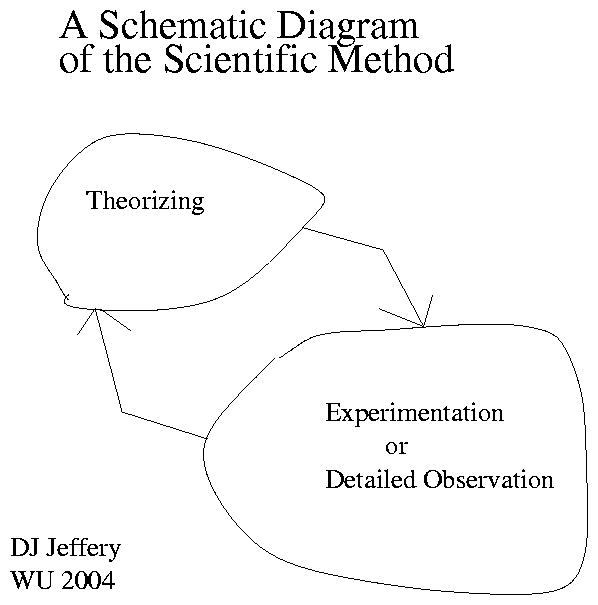
Caption: A schematic diagram of the scientific method.
Features:
- The diagram shows the
scientific method
is a cyclic
process
of theory
and
experimentation/observation.
- In terms of content, the results of the
scientific method can be regarded as
a spiral---UPWARD/INWARD/OUTWARD---choose
the appropriate metaphor.
- Astronomy is a slightly special case in that
it is primarily limited to detailed observation.
We cannot experiment on most astronomical objects.
Spacecraft can do limited experimentation, of course.
And of course, Earth-based experimentation is vital to understanding the nature of astronomical objects.
- The scientific method
is at least vaguely distinct from the
trial-and-error method
in that it aims at general theoretical understanding, NOT just a limited solution to
a particular problem.
- Now the scientific method was
vaguely practiced by people going far back in
history.
Aristotle (384--322 BCE) is a key example
practitioner (Wikipedia:
History of scientific method: Aristotle).
However, as
the rule for doing science,
it had to be discovered.
This discovery was in
the 17th century, first through example
and then by clear statement.
For key example, we can cite the procedures of
Galileo (1564--1642)
and Johannes Kepler (1571--1630).
For clear statement,
maybe the first is:
-
... the Understanding ... is
to begin with the
Hands and Eyes,
and to proceed on the
through the Memory, to be continued by the
Reason; nor is it to stop there, but to come
about to the
Hands and Eyes
again, and so, by a continual passage round from one
Faculty to another, it is
to be maintained in life
and strength,
as much as the body of
man is by the
circulation of the blood.
-
---Robert Hooke (1635--1703)
discovers the scientific method---quoted
from
How Modern Science Came into the World, 2011, p. 487 by
H. Floris Cohen (1946--).
Note the circulation of the blood
was discovered in 1628
by William Harvey (1578--1657)
Wikipedia: Circulatory system: History,
and so Hooke's
simile was in his day modern,
newfangled, and
sciency.
There seems NO record that
Hooke ever met
Harvey, who was a much older person,
but they probably had acquaintances in common---so maybe
2 degrees of separation.
- In fact, yours truly believes that the
scientific method
can be proven to work in the ideal limit: i.e., to give truth.
The proof follows from
Bayesian analysis
in the ideal limit since
Bayesian analysis
is, in fact, the scientific method
quantified.
See
An Educational Note on Bayesian Analysis in Dialogue Form
(2024).
Image link: Itself.
Local file: local link: sci_method.html.
File: Science file: sci_method.html.